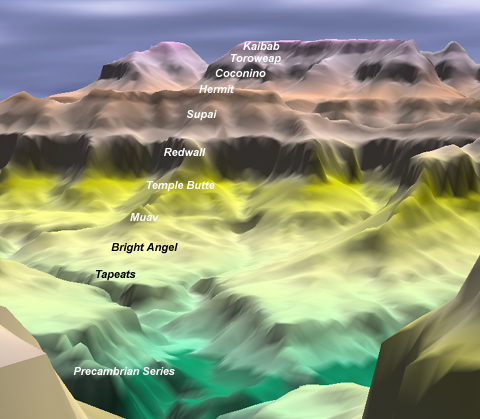In chapter 8, you were introduced to the concepts of geologic time. There
is no doubt among geologists that Earth's history is long and complex - spanning
at least 4.5 billion years. Recent discoveries in Australia have yielded the
oldest terrestrial rocks yet recovered - 4.3 to 4.4 billion years old.
The spectacular succession of strata and the sheer beauty of the Grand Canyon
of the Colorado River (Arizona, USA) has attracted geologists for over a century.
Exposed in the walls of the canyon are rocks formed over a good deal of Earth's
long history.
 <a onClick="window.open('/olcweb/cgi/pluginpop.cgi?it=jpg::::/sites/dl/free/0072826967/30425/VirtualVista0801.jpg','popWin', 'width=NaN,height=NaN,resizable,scrollbars');" href="#"><img valign="absmiddle" height="16" width="16" border="0" src="/olcweb/styles/shared/linkicons/image.gif"> (107.0K)</a>
<a onClick="window.open('/olcweb/cgi/pluginpop.cgi?it=jpg::::/sites/dl/free/0072826967/30425/VirtualVista0801.jpg','popWin', 'width=NaN,height=NaN,resizable,scrollbars');" href="#"><img valign="absmiddle" height="16" width="16" border="0" src="/olcweb/styles/shared/linkicons/image.gif"> (107.0K)</a>
The image above was derived from a digital elevation model of a portion of
the Grand Canyon and rendered using Geographic Information System (GIS) software.
The view is looking down the axis of the canyon along the path of the Colorado
River, which flows at the bottom of the inner gorge. The colors in this view
represent elevations of the cliffs and bluffs of the canyon, but they might
also evoke images of the horizontally layered sedimentary rocks that compose
the stratigraphic succession of the canyon.
The image below is another virtual view of the canyon from the South Rim.
Looking across the canyon, each of the major strata of the canyon succession
can be identified in the canyon walls. In the Inner Gorge of the canyon, rocks
of the Precambrian interval form the deepest and oldest exposures in the canyon.
 <a onClick="window.open('/olcweb/cgi/pluginpop.cgi?it=jpg::::/sites/dl/free/0072826967/30425/VirtualVista0802.jpg','popWin', 'width=NaN,height=NaN,resizable,scrollbars');" href="#"><img valign="absmiddle" height="16" width="16" border="0" src="/olcweb/styles/shared/linkicons/image.gif"> (143.0K)</a>
<a onClick="window.open('/olcweb/cgi/pluginpop.cgi?it=jpg::::/sites/dl/free/0072826967/30425/VirtualVista0802.jpg','popWin', 'width=NaN,height=NaN,resizable,scrollbars');" href="#"><img valign="absmiddle" height="16" width="16" border="0" src="/olcweb/styles/shared/linkicons/image.gif"> (143.0K)</a>
Despite the spectacular exposures of rocks spanning a good portion of Earth's
history, it is important to note that the record of Earth's history preserved
in these rocks is not complete, even here at the Grand Canyon.
The contact separating rocks of the Precambrian series from the overlying
Tapeats Formation is an unconformity. Below the unconformity, rocks
are older than 1 billion years. Above the unconformity, the Tapeats Formation
is approximately 550 million years old (0.5 billion). Thus, the unconformity
separating the Precambrian series from the oldest horizontal layer spans an
interval of time longer than that represented by the complete thickness of
the horizontal strata to the canyon rim!
The Grand Canyon
is a marvelous example of the nature of the geologic record on Earth. Even
though there is a good record of events in Earth's history at this site, it
is not complete and geologists must rely on evidence from other areas to fill
in the gaps.


